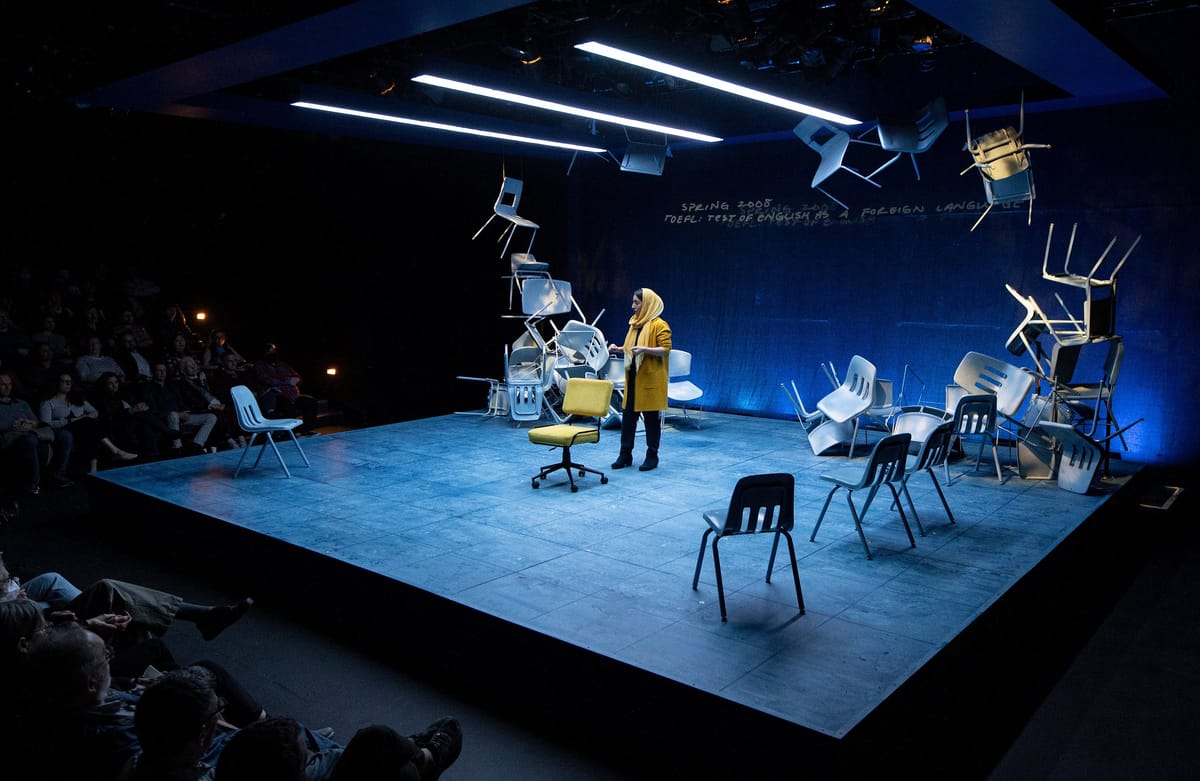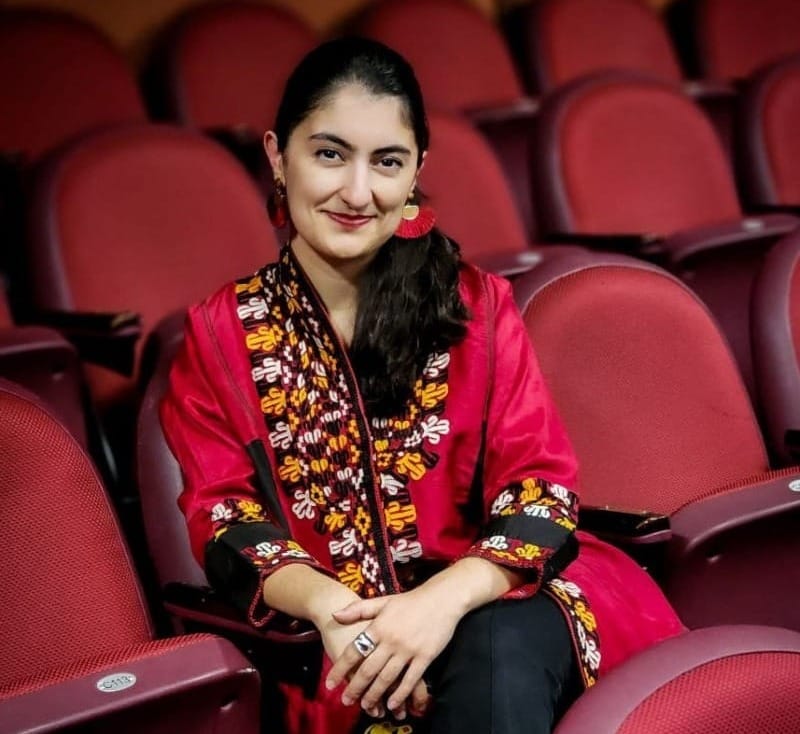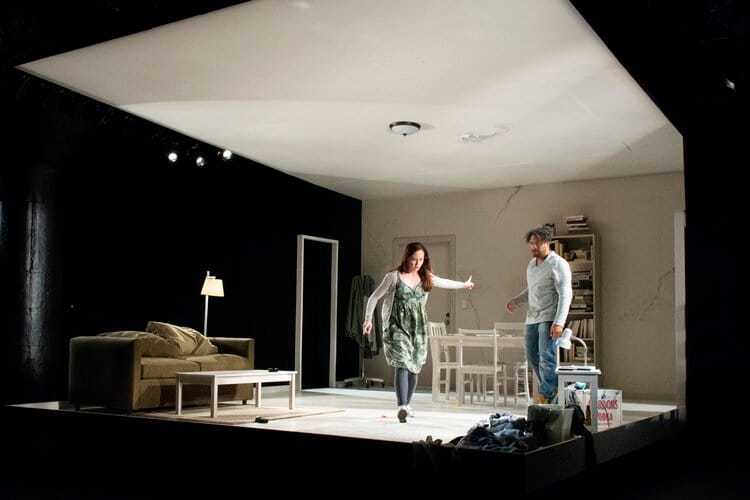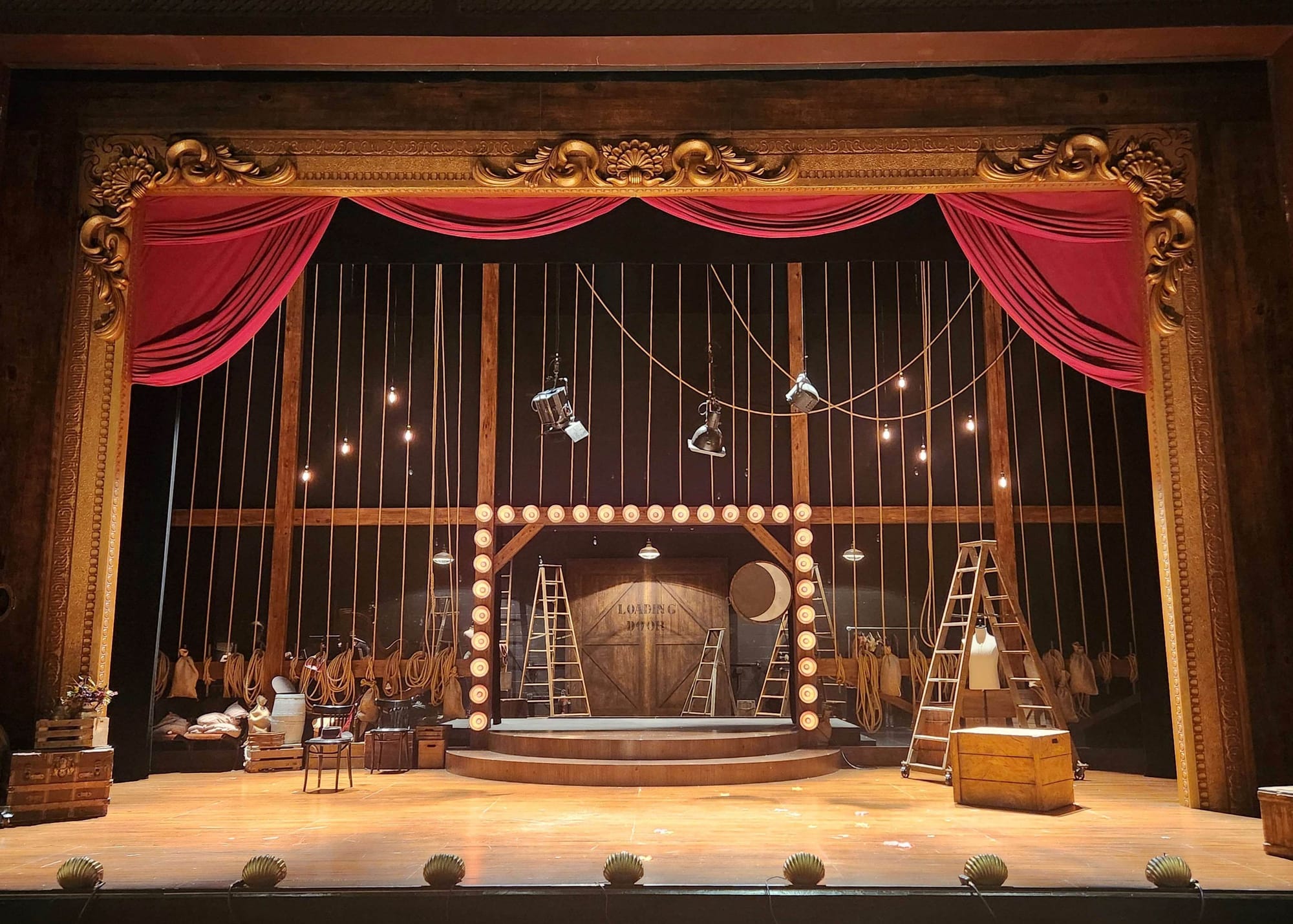Scenic Designer Parmida Ziaei Creates Visual Poetry for Theatregoers
A profile on scenic designer Parmida Ziaei | By Todd Matthews

For many theatregoers, anticipation fills that short distance separating a brightly lit lobby and a dimmed house. That first glimpse of the set, free of actors, can set the mood and build anticipation for what’s in store over the next couple of hours. If you’ve attended local theatre recently, Parmida Ziaei, one of the Puget Sound region’s busiest scenic designers, has probably influenced that moment.
In the first six months of this year alone, Ziaei has created scenic designs for Seattle Public Theater’s Once More, Just for You, Seattle Shakespeare Company’s The Bed Trick, Village Theatre’s The Fantasticks!, ACT Theatre’s Stew and A Case for the Existence of God, and the Seda Iranian Theatre Ensemble/ArtsWest co-production of English.
“When I see Parmida’s work, I’m always stunned by a few things,” said Village Theatre Artistic Director Adam Immerwahr. “She manages to create visually arresting scenery—an ink-drop sky in Sense and Sensibility, bold colors in The Bed Trick—deeply integrated with the play, highlighting the play’s tone, spirit, mood, and even metaphors. She’s great at finding a way to create a set that instantly gives you a feeling for what kind of world you’re entering, which supports the production so wonderfully because the audience is already part of the way onto the journey of what your play is about.”
The importance of scenic design, especially an audience’s first glimpse at the set, is not lost on Ziaei. “The set is the first thing people see, and it affects how you perceive the show,” she explained. “The set is going to have a huge impression on the audience. I try to find the poetry or the subtext in the play because that often informs the design more than what you see on paper.”

Ziaei’s connection to theatre, as well as dance and choreography, dates to her experience as a high school student in Iran, where she was born and raised. She loved being on stage, especially when students and teachers converted classrooms into performing arts spaces. “We had this event in school every year—we couldn’t call it a dance because that would be problematic in Iran—where I always set it up and did the costumes,” she recalled. “Looking back now, it was like scenic design but on a miniature scale.”
After high school, she moved to the United States in 2012 to attend the University of California, Berkeley, where she earned a bachelor’s degree in architecture at her parents’ urging. According to Ziaei, 30, architecture is a popular major in Iran, especially for women. “I didn’t see myself becoming a licensed architect,” said Parmida, who minored in theatre and performance studies. “I thought I would change my major to art, but I just stuck with architecture even though I knew I didn’t love it.”
In 2016, she moved to Seattle and, two years later, landed a design job at Hotopp Creative Studio. She tried to make inroads into Seattle’s theatre community, introducing herself as an architect interested in scenic design, but found it difficult to make connections without a portfolio of scenic theatre design work. That changed in 2017 when she decided to attend a holiday party hosted by Theatre Puget Sound and met Sound Theatre Company’s founder and co-artistic director, Teresa Thuman.
Thuman introduced Ziaei to Sound Theatre Company’s team, including artistic producer Margaret Toomey and scenic designer Robin Macartney. She was enlisted to assist Macartney with the company’s production of You Can’t Take It With You at the Center Theatre at Seattle Center. A few months later, Ziaei was leading the design of her first major show, Sound Theatre Company’s production of John Belluso’s The Rules of Charity, also at Seattle Center.
“That was my big break,” Ziaei said. “I always tell Teresa she opened the door for me.”
Ziaei showed her ability to convey a play’s tone and mood through scenic design during the Seattle premiere of The Rules of Charity, a provocative play exploring issues of confinement, marginalization, and disability through a queer father, Monty, who is wheelchair-bound and suffering the effects of Cerebral Palsy, and his adult daughter, Loretta, who serves as his caretaker.

To imbue a sense of suffocating confinement, Ziaei raised the stage’s floor so Monty could not leave the apartment in his wheelchair and created a tilted ceiling to compress the space further, creating for audiences the feeling of peering into the apartment. “Immediately, when you put a ceiling on a space, it feels more contained,” said Ziaei. “Also, everything in the room was monochrome. It took life out of the room and made it feel like a hospital. That’s how I thought this man felt in his home.”
Thuman recalled the show’s clean, elegant, and sophisticated design, which made it hard for her to believe it was the work of an early scenic designer. “There was something very transformative about the space,” Thuman explained. “That feeling of looking inside a box where someone lives in isolation was beautifully done. Parmida had an open and empathetic spirit that embraced the story and [Monty’s] journey. It seemed natural for her. I watched it unfold and thought, ‘Whoa, this is wonderful. What a great artist. What a beautiful piece.’”
Since that debut in 2018, Ziaei has designed roughly four dozen sets for nearly two dozen organizations, including ACT Theatre, ArtsWest, Macha Theatre Works, Seattle Pacific University, Seattle Public Theater, Seattle Shakespeare Company, Sound Theatre Company, Taproot Theatre Company, Theatre22, Village Theatre, and Washington Ensemble Theatre. She served on Sound Theatre Company’s board, was Macha Theatre Works’ resident scenic designer, and earned Village Theatre’s Northwest Creator Residency in 2022. She was also nominated for two Gypsy Rose Lee Awards in 2020 for her scenic designs for Macha Theatre Works’ Sheathed and Theatre22’s White (a co-nomination with Toomey).
She has earned critical raves along the way, with BroadwayWorld describing her work on The Bed Trick as “genius,” Sense and Sensibility as “charm itself” and “nothing less than ethereal,” and Sound Theatre Company’s Cloud Tectonics as “transcendent and lovely” and capturing “ethereal beauty.”
Seattle Public Theater’s producing artistic director, Amy Poisson, has worked with Ziaei on a half-dozen shows for two different theatre companies over the past six years. One of Poisson’s favorite sets was Macha Theatre Works’ production of Lisa Every and Jenn Ruzumna’s play The Fifth Wave, which posed many scenic design challenges. During each performance, actors used a sledgehammer to smash a wall that had to be easily rebuilt between shows. But the show’s most visible and impressive scenic design was a collection of five columns extending out over the audience and threaded with rope lights. Ziaei worked closely with lighting designer Dani Norberg to create a unique effect of light glowing from within the set, shifting with each character’s changing emotions.

“It was a daunting task,” Poisson said. “But the thing about working with Parmida is that I don’t have to start from a place of, ‘No, we can’t do that.’ She comes to every project saying, ‘Yes, we’re going to figure this out, and it’s going to be awesome.’ That’s how theatre gets made. That’s the magic of Parmida.”
This summer, Ziaei will take a break from scenic design to serve as the cultural consultant for Barzin Akhavan’s solo show Behfarmaheen (If You Please) at the Oregon Shakespeare Festival. She’s already on tap to design shows this fall and early next year, including Camelot at Village Theatre and The Park at Seattle Public Theater. She’s also busy helping to lead the Seda Iranian Theatre Ensemble, which provides opportunities to create, produce, and teach theatre works of Iranian and other immigrant nationalities.
“The variety is what I get excited about. My goal is to be free to do different types of work.”
In the long term, Ziaei envisions working on productions throughout the United States and overseas. “Sometimes, people tell me, ‘You do so many things. What do you really like to do?’” Ziaei said. “The variety is what I get excited about. My goal is to be free to do different types of work. I still love performing and choreographing. I want to work on more than just theatre projects—immersive attractions or even theme parks, creating worlds and sets for people to experience.”
Early in our interview, Ziaei described her parents’ concern when she left the relatively safe and steady architecture profession to pursue her dream of becoming a full-time scenic designer. Are you sure you want to do that? Today, she said, they are very supportive—especially considering how busy she is and how she’s managed to make it work. “My dad comes to every opening night,” she added. “Even if he doesn’t understand the show, he still says, ‘That was good.’”



